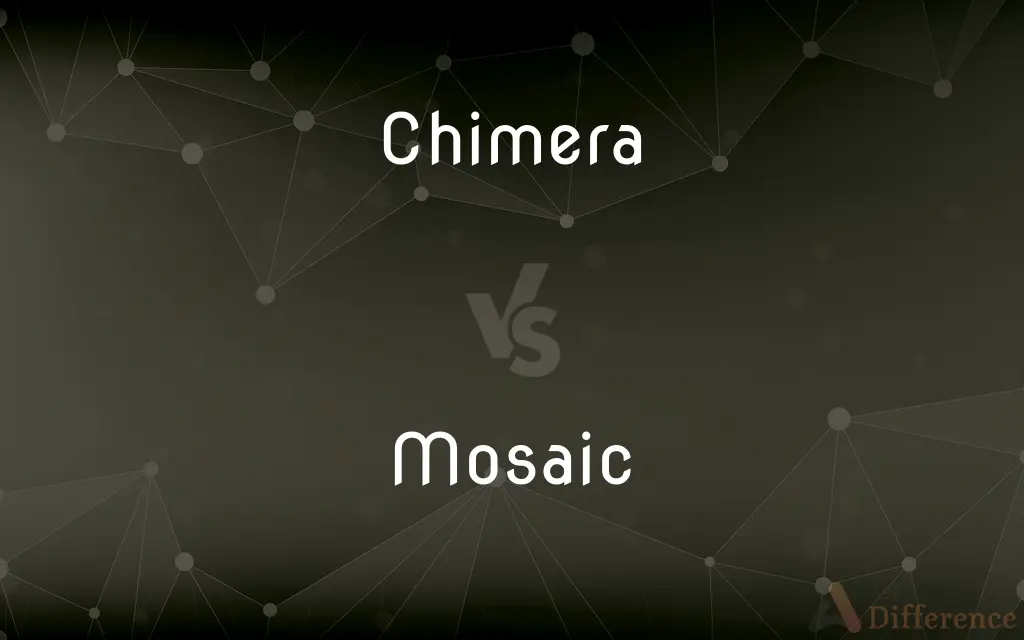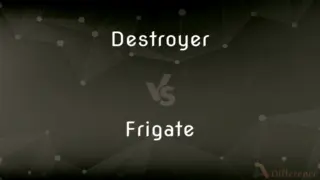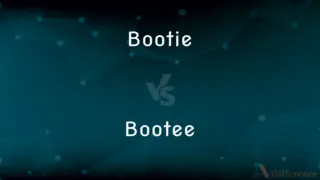Chimera vs. Mosaic — What's the Difference?
Edited by Tayyaba Rehman — By Fiza Rafique — Updated on September 30, 2023
Chimera refers to an organism with cells from different zygotes, while Mosaic indicates an organism with cells differing in genotype due to mutations. Both involve mixed cell origins but differ in genesis.

Difference Between Chimera and Mosaic
Table of Contents
ADVERTISEMENT
Key Differences
Chimera and Mosaic, both in the realm of biology, refer to organisms or tissues that contain two or more different sets of DNA. However, the origin and nature of this genetic mixture vary between the two. Chimera often arises from the merging of two or more different zygotes, leading to an organism with cells from different genetic sources. In contrast, a Mosaic organism originates from a single zygote but has cells that differ in genotype due to mutations during cell division.
In the context of plants, a Chimera might form when tissues from two different plants fuse, leading to a plant with a mix of characteristics from both parent plants. Mosaic plants, on the other hand, may exhibit varied patterns on their leaves or flowers due to genetic mutations affecting only certain cells or tissues.
Outside of biology, Chimera also references a mythological beast composed of parts from various animals, symbolizing its mixed nature. Mosaic, however, predominantly connects to art and design, referring to a pattern or picture made by arranging small colored pieces of hard material, like stone or tile.
In summary, while both Chimera and Mosaic allude to mixed origins, their genesis and implications differ. Chimera emphasizes a blend from multiple sources, while Mosaic highlights variation within a single entity due to localized changes.
Comparison Chart
Biological Origin
Results from merging of two or more different zygotes.
Originates from mutations during cell division in a single zygote.
ADVERTISEMENT
In Plants
Can result from tissue fusion of two different plants.
Genetic mutations causing varied patterns on parts like leaves.
Outside Biology
Refers to a mythological creature with mixed parts from various animals.
Artwork made from small, colored pieces of hard material.
Implication
Emphasizes mixture from multiple distinct sources.
Highlights variation within a single entity due to localized changes.
Cell Composition
Contains cells from different genetic sources.
Contains cells with differing genotypes from a single source due to mutations.
Compare with Definitions
Chimera
A Chimera is an organism comprising cells from more than one zygote.
The goat-sheep hybrid is an example of a Chimera.
Mosaic
In biology, a Mosaic organism has cells with different genotypes due to mutations.
The Mosaic corn plant has kernels of varied colors due to genetic mutations.
Chimera
(genetics) An organism with genetically distinct cells originating from two or more zygotes.
The DNA test returned a false negative because the killer was a chimera, having absorbed her twin in utero.
Mosaic
A Mosaic is a design composed of small pieces of colored stone, glass, or other materials.
The ancient Roman floors often featured intricate Mosaic patterns.
Chimera
In genetics, Chimera refers to an individual organism with different types of cells.
A Chimera mouse might have both black and white fur patches due to its mixed cell origins.
Mosaic
Mosaic can also imply a composite picture or pattern.
The artist's Mosaic depicted a serene landscape using fragments of colored glass.
Chimera
Chimera is also used figuratively to describe a dream or illusion.
His ambition of world peace seemed like a Chimera to many.
Mosaic
Figuratively, Mosaic might refer to a diverse or varied mix.
The city was a Mosaic of cultures and traditions.
Chimera
Greek Mythology A fire-breathing female monster usually represented as a composite of a lion, goat, and serpent.
Mosaic
A mosaic is a pattern or image made of small regular or irregular pieces of colored stone, glass or ceramic, held in place by plaster/mortar, and covering a surface. Mosaics are often used as floor and wall decoration, and were particularly popular in the Ancient Roman world.
Chimera
An imaginary monster made up of grotesquely disparate parts.
Mosaic
A picture or pattern produced by arranging together small pieces of stone, tile, glass, etc.
The walls and vaults are decorated by marble and mosaic
Mosaics on the interior depict scenes from the Old Testament
Chimera
An organism, organ, or part consisting of two or more tissues of different genetic composition, produced as a result of organ transplant, grafting, or genetic engineering.
Mosaic
An individual (especially an animal) composed of cells of two genetically different types.
Chimera
A gene or protein consisting of parts from two different genes or proteins that are normally distinct, sometimes derived from two different species.
Mosaic
A virus disease that results in leaf variegation in tobacco, maize, sugar cane, and other plants.
Chimera
An individual who has received a transplant of genetically and immunologically different tissue.
Mosaic
Decorate with a mosaic
He mosaicked the walls, ceilings, and floors
Chimera
A fanciful mental illusion or fabrication.
Mosaic
Of or associated with Moses.
Chimera
(Greek mythology) Chimera, a supposed monster in Lycia with the head of a lion, body of a goat, and tail of a dragon or serpent, killed by the hero Bellerophon.
The game includes a bunch of chimeras, with the lion heads shooting fire and the snake tails whipping around trying to bite the player.
Mosaic
Of or relating to Moses or the laws and writings attributed to him.
Chimera
Any fantastic creature combining parts from different animals.
Mosaic
A picture or decorative design made by setting small colored pieces, as of stone or tile, into a surface.
Chimera
(figurative) A foolish, incongruous, or vain thought or product of the imagination.
Mosaic
The process or art of making such pictures or designs.
Chimera
(figurative) Anything composed of very disparate parts.
Mosaic
A composite picture made of overlapping, usually aerial, photographs.
Chimera
(architecture) A grotesque like a gargoyle, but without a spout for rainwater.
Mosaic
Something that resembles a mosaic
A mosaic of testimony from various witnesses.
Chimera
(zoology) chimaera, a cartilaginous marine fish in the subclass Holocephali and especially the order Chimaeriformes, with a blunt snout, long tail, and a spine before the first dorsal fin.
Mosaic
(Botany) A viral disease of plants, resulting in light and dark areas in the leaves, which often become shriveled and dwarfed.
Chimera
(figurative) bogeyman: any terrifying thing, especially as an unreal, imagined threat.
Mosaic
An array of photosensitive elements in a video camera that react to light and are scanned by other components to compose an image.
Chimera
A monster represented as vomiting flames, and as having the head of a lion, the body of a goat, and the tail of a dragon.
Mosaic
(Biology) An individual exhibiting mosaicism.
Chimera
A vain, foolish, or incongruous fancy, or creature of the imagination; as, the chimera of an author.
Mosaic
To make by mosaic
Mosaic a design on a rosewood box.
Chimera
(Greek mythology) fire-breathing she-monster with a lion's head and a goat's body and a serpent's tail; daughter of Typhon
Mosaic
To adorn with or as if with mosaic
Mosaic a sidewalk.
Chimera
A grotesque product of the imagination
Mosaic
A piece of artwork created by placing colored squares (usually tiles) in a pattern so as to create a picture.
Chimera
Chimera can also denote a mythical creature, typically with a lion's head, goat's body, and serpent's tail.
In ancient tales, the Chimera was a formidable beast.
Mosaic
Pixelization method of censorship en
Chimera
In botany, Chimera plants contain cells from two different lineages.
Some variegated plants are Chimeras with distinct tissue types.
Mosaic
(genetics) An individual composed of two or more cell lines of different genetic or chromosomal constitution, but from the same zygote.
Mosaic
(plant disease) Any of several viral diseases that cause mosaic-like patterns to appear on leaves.
Mosaic
A composite picture made from overlapping photographs.
Mosaic
(of an individual) Containing cells of varying genetic constitution.
Mosaic
(transitive) To arrange in a mosaic.
Mosaic
A surface decoration made by inlaying in patterns small pieces of variously colored glass, stone, or other material; - called also mosaic work.
Mosaic
A picture or design made in mosaic; an article decorated in mosaic.
Mosaic
Something resembling a mosaic{1}; something made up of different pieces, fitted together by design to form a unified composition.
Mosaic
Of or pertaining to the style of work called mosaic; formed by uniting pieces of different colors; variegated; tessellated; also, composed of various materials or ingredients.
A very beautiful mosaic pavement.
Mosaic
Of or pertaining to Moses, the leader of the Israelites, or established through his agency; as, the Mosaic law, rites, or institutions.
Mosaic
Art consisting of a design made of small pieces of colored stone or glass
Mosaic
Viral disease in solanaceous plants (tomatoes, potatoes, tobacco) resulting in mottling and often shriveling of the leaves
Mosaic
A freeware browser
Mosaic
A pattern resembling a mosaic
Mosaic
Transducer formed by the light-sensitive surface on a television camera tube
Mosaic
Assembly of aerial photographs forming a composite picture
Mosaic
Of or relating to Moses or the laws and writings attributed to him;
Mosaic Law
Mosaic
Decorated with small pieces of colored glass or stone fitted together;
A mosaic floor
A tessellated pavement
Mosaic
Mosaic is used in virology to denote a virus formed from segments of different strains.
Mosaic viruses can be particularly challenging due to their mixed origins.
Common Curiosities
Are all Chimeras a result of genetic engineering?
No, Chimeras can naturally occur, such as when twin embryos fuse, or they can be artificially created.
What's the connection between Chimera and Greek mythology?
In Greek mythology, a Chimera is a creature with a lion's head, goat's body, and serpent's tail.
What is a biological Chimera?
A Chimera is an organism that contains cells from two or more different zygotes.
Why might a plant show a Mosaic pattern on its leaves?
A Mosaic pattern in plants often results from mutations in certain cells, causing varied patterns or colors on leaves.
Can Mosaic patterns be found in architecture?
Yes, Mosaic designs, made from tiny colored pieces, have been used in floors, walls, and ceilings in various architectures.
How does a Mosaic pattern form in art?
A Mosaic is crafted by arranging small pieces of colored materials, like stone or glass, to form a design or image.
Share Your Discovery

Previous Comparison
Destroyer vs. Frigate
Next Comparison
Bootie vs. BooteeAuthor Spotlight
Written by
Fiza RafiqueFiza Rafique is a skilled content writer at AskDifference.com, where she meticulously refines and enhances written pieces. Drawing from her vast editorial expertise, Fiza ensures clarity, accuracy, and precision in every article. Passionate about language, she continually seeks to elevate the quality of content for readers worldwide.
Edited by
Tayyaba RehmanTayyaba Rehman is a distinguished writer, currently serving as a primary contributor to askdifference.com. As a researcher in semantics and etymology, Tayyaba's passion for the complexity of languages and their distinctions has found a perfect home on the platform. Tayyaba delves into the intricacies of language, distinguishing between commonly confused words and phrases, thereby providing clarity for readers worldwide.













































